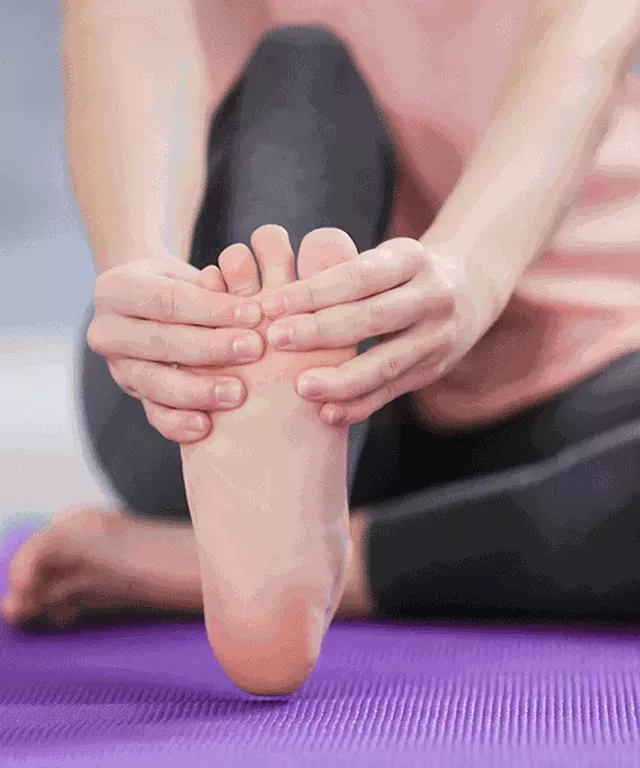Morton's Neuroma Treatment and Services Upper East Side, NYC
BOARD CERTIFIED PODIATRIST & SPORTS MEDICINE
SERVING UPPER EAST SIDE, MANHATTAN, MIDTOWN, NYC, NY AND THE SURROUNDING AREAS

Podiatrist Morton’s Neuroma Treatment and Surgery offered in Upper East Side, New York
PAIN IN THE BALL OF YOUR FOOT BETWEEN THE THIRD AND FOURTH TOES WHEN WALKING IS A COMMON SYMPTOM OF A NEUROMA. PODIATRIC CARE INVOLVING ADVANCED. SURGERY ISN’T YOUR ONLY OPTION FOR A STUBBORN NEUROMA. IF CONSERVATIVE CARE DOESN’T WORK, THERE ARE OTHER TREATMENTS AVAILABLE.
AT AIRE PODIATRY STUDIO ON MANHATTAN’S UPPER EAST SIDE IN NEW YORK CITY, DR. ERIN KOPRINCE, DPM, DABPM, AND DR. MONA RAMANI, DPM, AACFAS, PROVIDE CUTTING-EDGE TREATMENTS FOR NEUROMA, INCLUDING CRYOTHERAPY.
CALL THE OFFICE OR SCHEDULE YOUR NEUROMA CONSULTATION ONLINE TODAY.
Morton’s Neuroma Specialist Near Me
Treat Morton neuromas at your local podiatrist, Aire Podiatry in Manhattan, New York City. You don’t need to travel to receive the best treatment options. We’re on your doorstep.
Our state-of-the-art podiatry practice is on the Upper East Side of Manhattan. We are proud of the holistic approach we offer, putting our focus whole-body wellness, not just the foot and ankle.
After all, New Yorkers depend on their feet! Don’t compromise your foot health and long term comfort. Check out your foot pain and explore solutions for a pain-free walk.
What is a neuroma?
A neuroma is a nerve pain condition that develops when a nerve thickens. You can develop a neuroma in many areas of your body. But it most often affects the nerve in the ball of the foot between the third and fourth toe. This type of neuroma is called Morton’s neuroma.
The thickening of the nerve is caused by irritation and compression, which enlarges the nerve. Wearing shoes with a tapered toe box or high heel can cause irritation and nerve compression, leading to thickening. Dancers are prone to Morton’s neuroma.
People with foot deformities like bunions or hammertoe are more likely to develop a neuroma. A traumatic foot injury can also cause this nerve condition.
When left untreated, a neuroma can lead to permanent nerve damage.
What are the symptoms of a neuroma?
Neuroma symptoms tend to develop gradually. The symptoms cause discomfort when wearing some shoes or engaging in activities that aggravate the nerve. You could feel tingling, a burning pain, or numbness in the ball of your foot. Or it might feel like you have a pebble in your shoe.
When you remove your shoes and massage your feet, your symptoms might go away. Over time, though, your symptoms can worsen, becoming less responsive to at-home care.
If you suffer from pain in the ball of your foot, the podiatrists at AIRE Podiatry Studio can help.
How is a neuroma treated?
After completing a thorough history and physical, your podiatrist at AIRE Podiatry Studio creates your personalized treatment plan. Initially, this will include conservative care like:
- Changing your footwear
- Padding your shoes
- Icing your feet at the end of the day
- Changing your activities
- Custom-made orthotics (devices that go in your shoes to improve foot mechanics)
- Nonsteroidal anti-inflammatory drugs (NSAIDs)
- Cortisone injections
- Shockwave therapy (high-intensity acoustic waves that speed healing)
If these treatments don’t help, your AIRE Podiatry Studio podiatrist may recommend surgery or cryotherapy.
New treatments for Morton’s Neuroma offer hope for those suffering from foot pain. Breakthrough therapies like cryotherapy and shockwave therapy show promise in reducing inflammation and easing discomfort.
The use of custom orthotics can help provide better support and alleviate pressure on the affected nerve. In severe cases, surgical options such as nerve decompression may be considered.
Who benefits from cryotherapy for neuroma?
You could benefit from cryotherapy for your neuroma if conservative measures fail to relieve your symptoms. Cryotherapy, also called cryosurgery, is a minimally invasive treatment for a neuroma. It uses advanced technology to shrink the enlarged nerve to its normal size without damaging the nerve itself.
Call AIRE Podiatry Studio or schedule an appointment online today to learn more about neuroma treatment.
Neuroma
What is a neuroma?
A neuroma is a nerve pain condition that develops when a nerve thickens. You can develop a neuroma in many areas of your body, but it most often affects the nerve in the ball of the foot between the third and fourth toe. This type of neuroma is called Morton’s neuroma.
The thickening of the nerve is caused by irritation and compression, which enlarges the nerve. Wearing shoes with a tapered toe box or high heel can cause irritation and nerve compression, leading to thickening. Dancers are prone to Morton’s neuroma.
People with foot deformities like bunions or hammertoe are more likely to develop a neuroma. A traumatic foot injury can also cause this nerve condition.
When left untreated, a neuroma can lead to permanent nerve damage.
What are the symptoms of a neuroma?
Neuroma symptoms tend to develop gradually, causing discomfort when wearing some shoes or engaging in activities that aggravate the nerve. You could feel tingling, burning, or numbness in the ball of your foot. Or it might feel like you have a pebble in your shoe.
When you remove your shoes and massage your feet, your symptoms might go away. Over time, though, your symptoms can worsen, becoming less responsive to at-home care.
If you suffer from pain in the ball of your foot, the podiatrists at AIRE Podiatry Studio can help.
How is a neuroma treated?
After completing a thorough history and physical, your podiatrist at AIRE Podiatry Studio creates your personalized treatment plan. Initially, this will include conservative care like:
- Changing your footwear
- Padding your shoes
- Icing your feet at the end of the day
- Changing your activities
- Custom-made orthotics (devices that go in your shoes to improve foot mechanics)
- Nonsteroidal anti-inflammatory drugs (NSAIDs)
- Cortisone injections
- Shockwave therapy (high-intensity acoustic waves that speed healing)
When these kinds of treatments fail to improve your symptoms, your podiatrist at AIRE Podiatry Studio will suggest surgery or cryotherapy.
Who benefits from cryotherapy for neuroma?
You could benefit from cryotherapy for your neuroma if conservative measures fail to relieve your symptoms. Cryotherapy, also called cryosurgery, is a minimally invasive treatment for a neuroma. It uses advanced technology to shrink the enlarged nerve to its normal size without damaging the nerve itself.
Call AIRE Podiatry Studio or schedule an appointment online today to learn more about neuroma treatment.

